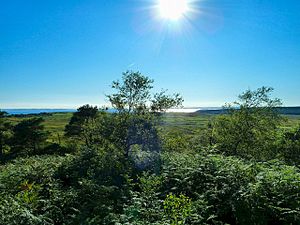Doon of May facts for kids
The Doon of May is a special place in south-west Scotland. It's a forest (called a conifer plantation) with an ancient Iron Age hill fort nearby. It's located in Dumfries and Galloway, about 14 kilometers (9 miles) west of Wigtown.
A group called the Tinne Beag Workers’ Co-operative bought this forest in 1999. They manage it carefully to use its wood and other products without harming nature. They also work to bring back native plants and increase the variety of life there, which is called biodiversity.
What is the Doon of May?
The Forest
The Doon of May forest covers about 100 acres (40 hectares). Much of it is planted with Sitka spruce trees. But there are also large areas of natural woodland with trees like oak, ash, beech, birch, Scots pine, willow, alder, and sycamore.
There's also a big wetland area, about 75 acres (30 hectares), which is a peat bog. This area is being replanted with trees like birch, rowan, willow, and oak. Inside the spruce forest, you can find many wet, open spaces with different types of sphagnum mosses.
The Ancient Hill Fort
The Doon of May gets its name from an Iron Age hill fort found on the south-west side of the forest. This fort is about 139 meters (456 feet) above sea level. From here, you can see amazing views of Luce Bay and even the coast of Ireland far away!
This fort was a walled settlement, shaped like an oval. It measured about 43 meters (140 feet) from east to west and 30 meters (100 feet) from north to south. The wall around it was very strong, up to 3 meters (10 feet) high on the south side. The main entrance was probably from the west.
The fort's walls were "vitrified," which means they were heated so much that the stones melted and fused together. This made them extra strong! Natural cliffs around the site also helped protect it. The Doon of May hill fort is a very important historical site and is protected as a scheduled monument.
What's Around Doon of May?
The northern edge of the Doon of May forest touches Mochrum Loch. This loch is a very important natural area, known as a Site of Special Scientific Interest. It's home to Britain's largest group of cormorants that nest inland.
The forest is also next to part of the Sustrans National Cycle Network, which is a great place for cycling. You can also find a Peace Pole on the eastern side of the public road that goes through the forest.


